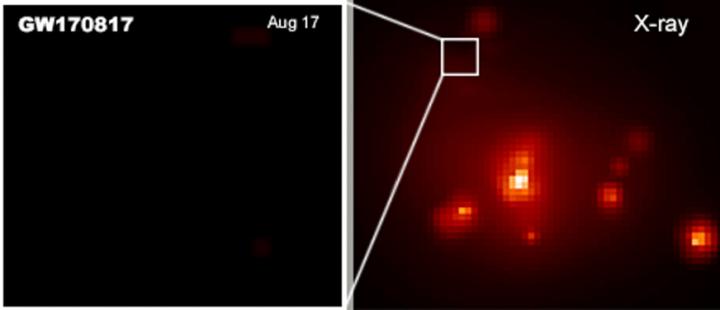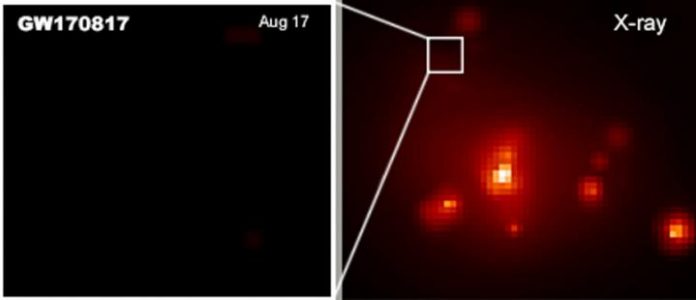
Photo: Researchers have continuously monitored the radiation emanating from the first (and so far only) cosmic event detected in both gravitational waves and the entire spectrum of light. The neutron star…
view more
Credit Image: Image credit: E. Troja
It’s been three years since the landmark detection of a neutron star merger from gravitational waves. And since that day, an international team of researchers led by University of Maryland astronomer Eleonora Troja has been continuously monitoring the subsequent radiation emissions to provide the most complete picture of such an event.
Their analysis provides possible explanations for X-rays that continued to radiate from the collision long after models predicted they would stop. The study also reveals that current models of neutron stars and compact body collisions are missing important information. The research was published on October 12, 2020, in the journal Monthly Notices of the Royal Astronomical Society.
“We are entering a new phase in our understanding of neutron stars,” said Troja, an associate research scientist in UMD’s Department of Astronomy and lead author of the paper. “We really don’t know what to expect from this point forward, because all our models were predicting no X-rays and we were surprised to see them 1,000 days after the collision event was detected. It may take years to find out the answer to what is going on, but our research opens the door to many possibilities.
The neutron star merger that Troja’s team studied–GW170817–was first identified from gravitational waves detected by the Laser Interferometer Gravitational-wave Observatory and its counterpart Virgo on August 17, 2017. Within hours, telescopes around the world began observing electromagnetic radiation, including gamma rays and light emitted from the explosion. It was the first and only time astronomers were able to observe the radiation associated with gravity waves, although they long knew such radiation occurs. All other gravity waves observed to date have originated from events too weak and too far away for the radiation to be detected from Earth.
Seconds after GW170817 was detected, scientists recorded the initial jet of energy, known as a gamma ray burst, then the slower kilonova, a cloud of gas which burst forth behind the initial jet. Light from the kilonova lasted about three weeks and then faded. Meanwhile, nine days after the gravity wave was first detected, the telescopes observed something they’d not seen before: X-rays. Scientific models based on known astrophysics predicted that as the initial jet from a neutron star collision moves through interstellar space, it creates its own shockwave, which emits X-rays, radio waves and light. This is known as the afterglow. But such an afterglow had never been observed before. In this case, the afterglow peaked around 160 days after the gravity waves were detected and then rapidly faded away. But the X-rays remained. They were last observed by the Chandra X-ray Observatory two and a half years after GW170817 was first detected.
The new research paper suggests a few possible explanations for the long-lived X-ray emissions. One possibility is that these X-rays represent a completely new feature of a collision’s afterglow, and the dynamics of a gamma ray burst are somehow different than expected.
“Having a collision so close to us that it’s visible opens a window into the whole process that we rarely have access to,” said Troja, who is also a research scientist at NASA’s Goddard Space Flight Center. “It may be there are physical processes we have not included in our models because they’re not relevant in the earlier stages that we are more familiar with, when the jets form.”
Another possibility is that the kilonova and the expanding gas cloud behind the initial jet of radiation may have created their own shock wave that took longer to reach Earth.
“We saw the kilonova, so we know this gas cloud is there, and the X-rays from its shock wave may just be reaching us,” said Geoffrey Ryan, a postdoctoral associate in the UMD Department of Astronomy and a co-author of the study. “But we need more data to understand if that’s what we’re seeing. If it is, it may give us a new tool, a signature of these events that we haven’t recognized before. That may help us find neutron star collisions in previous records of X-ray radiation.”
A third possibility is that something may have been left behind after the collision, perhaps the remnant of an X-ray emitting neutron star.
Much more analysis is needed before researchers can confirm exactly where the lingering X-rays came from. Some answers may come in December 2020, when the telescopes will once again be aimed at the source of GW170817. (The last observation was in February, 2020.)
“This may be the last breath of an historical source or the beginning of a new story, in which the signal brightens up again in the future and may remain visible for decades or even centuries,” Troja said. “Whatever happens, this event is changing what we know about neutron star mergers and rewriting our models.”
###
Additional authors of the paper from the UMD Department of Astronomy are Faculty Assistant Brendan O’Connor and Adjunct Associate Professor Stephen Cenko.
This work was partially supported by NASA (Chandra Award Nos. G0920071A, NNX16AB66G, NNX17AB18G, and 80NSSC20K0389.), the Joint Space-Science Institute Prize Postdoctoral Fellowship, and the European Union Horizon 2020 Programme (Award No. 871158). The content of this article does not necessarily reflect the views of these organizations.
The research paper, “A thousand days after the merger: continued X-ray emission from GW170817,” E. Troja, H. van Eerten, B. Zhang, G. Ryan, L. Piro, R. Ricci, B. O’Connor, M. H. Wieringa, S. B. Cenko, T. Sakamoto, was published on October 12, 2020, in Monthly Notices of the Royal Astronomical Society.
Media Relations Contact: Kimbra Cutlip, 301-405-9463, [email protected]
University of Maryland
College of Computer, Mathematical, and Natural Sciences
2300 Symons Hall
College Park, Md. 20742
http://www.
@UMDscience
About the College of Computer, Mathematical, and Natural Sciences
The College of Computer, Mathematical, and Natural Sciences at the University of Maryland educates more than 9,000 future scientific leaders in its undergraduate and graduate programs each year. The college’s 10 departments and more than a dozen interdisciplinary research centers foster scientific discovery with annual sponsored research funding exceeding $200 million.















